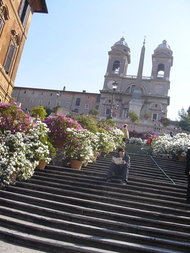Spanish Steps
|
|

Roma_-_Piazza_di_Spagna_-_maggio_2005.jpg
The Spanish Steps (Scalinata di Spagna) in Rome ramp a steep slope between the Piazza di Spagna at the base and the church Trinità dei Monti above. The monumental stairway, of 138 steps, was built with French diplomat Stefano Gueffier’s funds (20.000 "scudi") in 1723‑1725, linking the Bourbon Spanish embassy to the Holy See, today still located in the piazza below, with the Trinità dei Monti church above.
The Spanish Steps were designed by Francesco De Sanctis after generations of heated discussion over how the steep slope to the church on a shoulder of the Pincio should be urbanized. The solution is a gigantic inflation of some conventions of terraced garden stairs.
During Christmas time an impressive 19th century crib is assembled in the firs terrace of the staircase. During May, half of the monument is covered by flowerpots full of azalea plants. Although some impolite tourists consider the Spanish steps a favourite place for eating lunch or playing music, such behaviour is strictly forbidden and heavily fined. The apartment that was the setting for The Roman Spring of Mrs Stone (1961) is halfway up on the right.
The Spanish Steps have been restored several times, most recently in 1995.
In the Piazza at the base is the Early Baroque fountain called the Barcaccia ('the ugly boat'), often credited to Pietro Bernini, father of a more famous son.
In the Piazza, at the corner on your right as you begin to climb the steps, is the house where English poet John Keats lived and died in 1821; it is now a museum dedicated to his memory, full of memorabilia of the English Romantic generation. On the same right side you can see the 15th century former cardinal Cybo’s palace, now Ferrari di Valbona, building altered in the 1936 by famous architect Marcello Piacentini, the main town planner during Fascism, with impressive unique modern terraces perfectly in harmony with the surrounding baroque contest.
Piazza_di_Spagna.jpg
At the top the Viale ramps up the Pincio which is the Pincian Hill, omitted, like the Janiculum, from the classic Seven hills of Rome
Though the façade of the church of Trinità dei Monti just misses becoming an architecturally cohesive unity, its twin towers dominate the ensemble. In 1494 St Francis di Paola, a Calabrian hermit, bought a vineyard from cardinal Ermolao Barbaro, former patriarch of Acquileia, and then obtained the authorization to establish a monastery from pope Alexander VI. In 1502 Louis XII began the Trinità dei Monti church next to this monastery. The church was consecrated in 1585 by the great urbanizing Pope Sixtus V, whose via Sistina connects the Piazza below with the Piazza del Popolo.
From 1828 these Italian properties are entrusted to the Order of the Dames du Sacre Coer, a French religious order, due to an agreement between pope Leone XII and Carlo X, king of France.
References
- Ferrari di Valbona, Carlo Alberto (1965). “I viventi diritti dell’Italia a palazzo Farnese alla scalinata ed alla Trinità dei Monti in Roma. Edizioni d’Arte in Roma.Italy.
- Pecchiai, Pio (1958). “Regesti dei documenti patrimoniali del Convento Romano della Trinità dei Monti”. Archivi anno XXV pagg.406-423
External links
- Piazza di Spagna website (http://www.piazzadispagna.it/)
- Spanish Steps Rome (http://www.compart-multimedia.com/virtuale/us/roma/spagna.htm) virtual reality movie and picture gallery
- Detailed information (http://www.romeartlover.it/Vasi40.html) with photos and 18th-century engravings by Giuseppe Vasi
- The Spanish Steps (http://www.panoramas.dk/fullscreen5/f3_rome.html) 360 degree panorama - QuickTime VR.de:Spanische Treppe
it:Piazza di Spagna pl:Schody Hiszpańskie sv:Spanska trappan
